Best Places to Live in New England
Whether you’re looking to settle into a new home or just a new daydream, our favorite New England towns and small cities are calling your name.
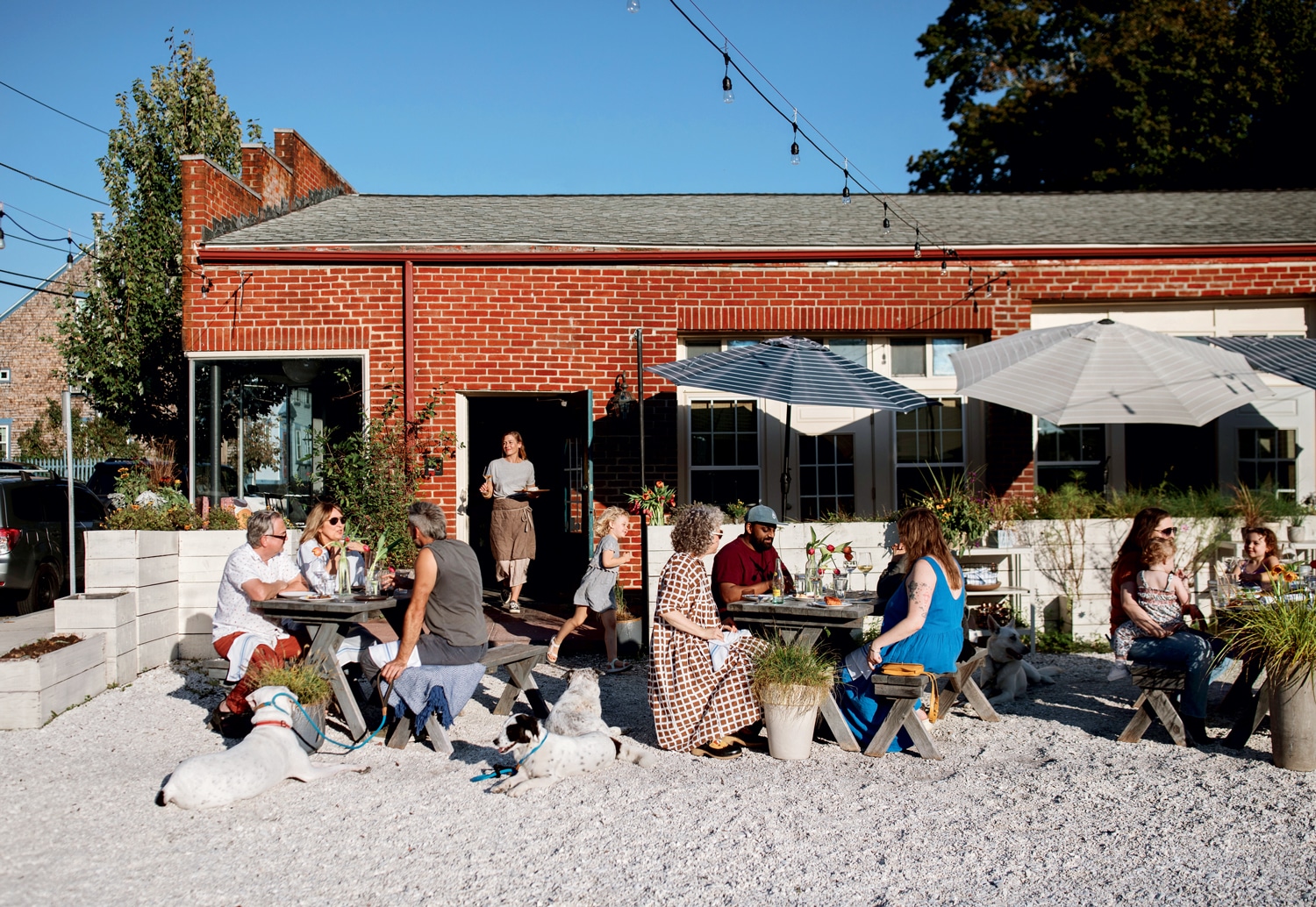
Coffee By Design | Portland, Maine
Photo Credit : Katherine KeenanWhenever I find myself in a new town, I wonder what it would be like to live there. To settle in, make a friend or two, wander around until the streets become familiar. Until it feels, well, like home. The sense of knowing what makes our own best place to live is elusive. Finding somewhere to love, to grow with, to enjoy remains one of life’s great rewards. But getting there often means going on a search, and being open to a new experience.
Ifyou have been feeling that tug—even just a bit—to look around, the following pages are meant to pique your curiosity, to crack open the door. We put them together by asking our editors and trusted writers what their own best town would be, knowing all the while that one person’s choice is unlikely to be another’s. If you love outdoor adventure, New England holds its own with any other region. But you may yearn instead for tranquil ocean waves, or for cities that excite you with shows and exhibits and more places to dine than days in a year. You may be drawn to a town settled in the 17th century, with homes that look as if they grew from the soil and where history is in the air. Or you may desire a sense of wilderness and solitude on your doorstep.
We also understand the reality of our times: One may simply hope to find a place to live without taking on crushing debt. It’s true we cannot talk about any place without considering what “affordable” means now. Throughout New England, median home prices these days hover near $400,000, a sum that only a decade ago would have seemed outrageous. The region, and the country, needs a staggering number of new homes—and the tension between knowing that and creating them will likely divide residents of many towns for years to come. But here, at least, we can shed light on some places that may surprise you with what “affordable” can offer.
This “Best Places” feature was great fun to create, as we, too, went on an odyssey to find and select our favorites. And in fact, we could have named 10 times as many worthy towns. That is the region’s gift to all of us. —Mel Allen
PS: No doubt many of you have “Best Places” picks of your own. We’d love to know not only the “where,” but also the “why.” Email us at editors@yankeepub.com or drop us a line at P.O. Box 520, Dublin, NH 03444.
About Our Numbers: Median home prices are for the first three quarters of 2023; populations are from the 2020 U.S. census.
UP-AND-COMING FOOD TOWN: Warren, RI
Pop. 11,147 | Median Home $482,000
The food ecosystem of Warren is so rich and varied that to call it “up-and-coming” may seem unfair, but in truth its delights are little known beyond Rhode Island. Just 20 minutes southeast of Providence, Warren retains its small-town feel while boasting a lineup of restaurants that hits every cuisine and price point. At the affordable end, you’ll find homey diner classics at Rod’s Grille, fish and chips at Amaral’s, and a time capsule of a soda fountain at Delekta Pharmacy, where a one-scoop coffee cabinet is the local go-to. There’s a cheese shop (Wedge), an excellent pasta shop (Prica Farina), a cidery (Sowams), a brewpub (The Guild), and a terrific coffee shop (Coffee Depot). The only missing element is a great bread bakery, but we see that Bywater, a sophisticated farm-and-sea-to-table restaurant, has just added a cozy bakeshop/café.
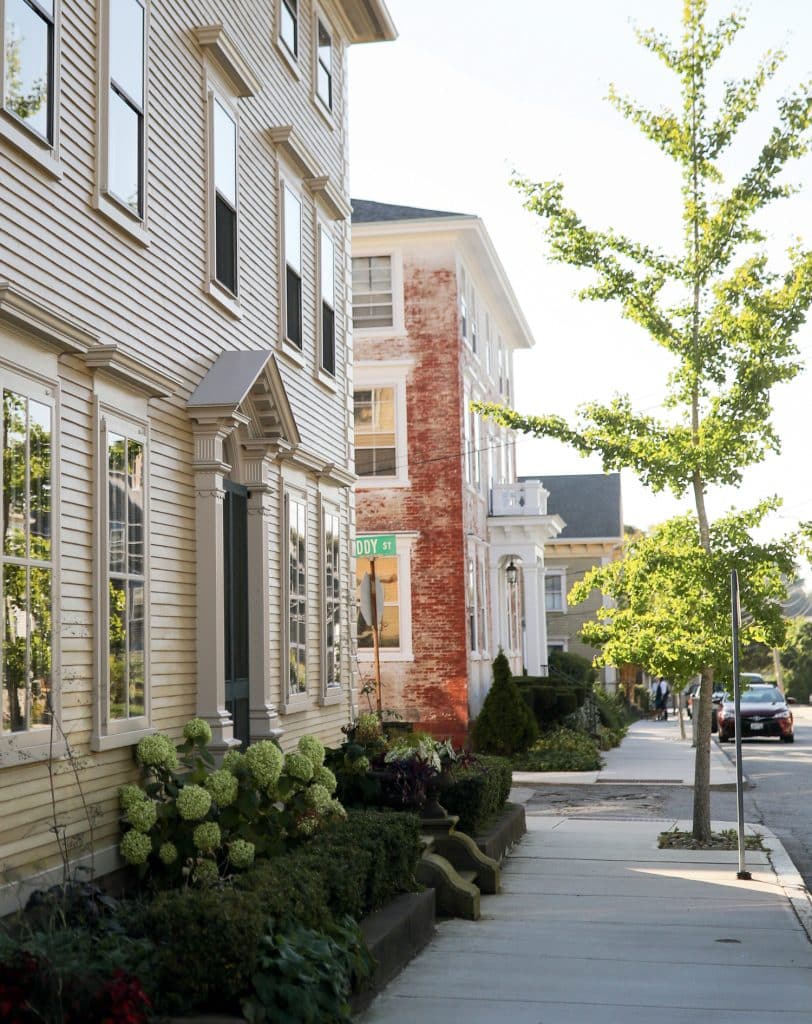
Photo Credit : Maaike Bernstrom

Photo Credit : Maaike Bernstrom
That said, the best thing about Warren’s food scene is that it’s still young and affordable enough to allow for quirky hybrids, such as Arc{hive}, a bookstore/bar/small-plates eatery, and the Galactic Theatre, a music venue/micro-cinema/bar. Added to these are eclectic restaurants like the Southern-accented Hunky Dory, creative-coastal Waterdog, and artful Metacom Kitchen, where Jacques Pépin was a recent guest. There’s even a food incubator, Hope & Main, that has launched businesses including Yankee Food Award winner Anchor Toffee. Come to think of it, why would those of us who love food live anywhere but here? —Amy Traverso
Worthy Alternative: Bristol, VT
This tiny hamlet punches above its weight with offerings that include Minifactory, a café/market where Yankee Food Awards honoree V Smiley makes her extraordinary jams; The Tillerman, an inn whose restaurant centers on wood-fired cooking; and the new Smoke and Lola’s, which turns out next-level comfort food. Don’t miss the Bicycle Mill Baking Co., which mills its own flour with bicycle power. Pop. 3,782; median home $382,500
Affordable Option: Bath, ME
Get your foot in the door now, folks: From the local bivalves and natural wine at the woman-owned OystHers Raw Bar & Bubbly, to the heavenly baked goods at Solo Pane, to the retro pleasures of deli/scoop shop The Fountain, this famous shipbuilding town is now on the foodie map. Pop. 8,766; median home $350,000

Photo Credit : Cait Bourgault
ADVENTURE TOWN: North Conway, NH
Pop. 2,116 (North Conway) | Median Home $445,500 (Town of Conway)
While other New England towns also draw an outdoorsy crowd, few can boast the variety of attractions and ease of access as North Conway, a village within the town of Conway and one of the most storied mountain destinations on the East Coast. Popular in the 19th century among hikers who strove to reach Mount Washington’s Tip Top House and landscape artists seeking to capture the grandeur of the White Mountains, North Conway cemented itself as the year-round capital of outdoor recreation when Hannes Schneider, an Austrian ski instructor, fled the Nazis in 1939 and settled in the valley. His ski school at Cranmore Mountain, just a few blocks from downtown, helped create an Alpine culture that brought vacationers in droves.
Ask a local what makes North Conway special today, and they’ll likely cite the sheer diversity of outdoor adventures found in and around the village. Novice hikers can trek Black Cap’s 2.3-mile trail, while elite climbers can tackle some of the most difficult ice routes in North America. There’s mountain biking, gravel cycling, and whitewater kayaking, too, not to mention first-class cross-country skiing at nearby Jackson XC. Whatever adventure you choose—and wherever you decide to grab your après burger and beer—you will understand as soon as you arrive why North Conway gets people’s hearts pumping. —Michael Wejchert
Worthy Alternative: Burke, VT
The action here centers on the village of East Burke, home to the mountain biking mecca Kingdom Trails as well as Burke Mountain, whose ski academy helped train future Olympians such as Mikaela Shiffrin. Swimmers and sunbathers will rejoice in stunning fjord-like Lake Willoughby, half an hour away. Pop. 1,651; median home $525,000
Affordable Option: Millinocket, ME
Having struggled after its paper mills closed, Millinocket is reemerging as a four-season gateway to “forever wild” Baxter State Park, while hosting a popular marathon and new maker spaces right in town. Seeing Mount Katahdin every day provides adventurers with both inspiration and motivation. Pop. 4,114; median home $122,000
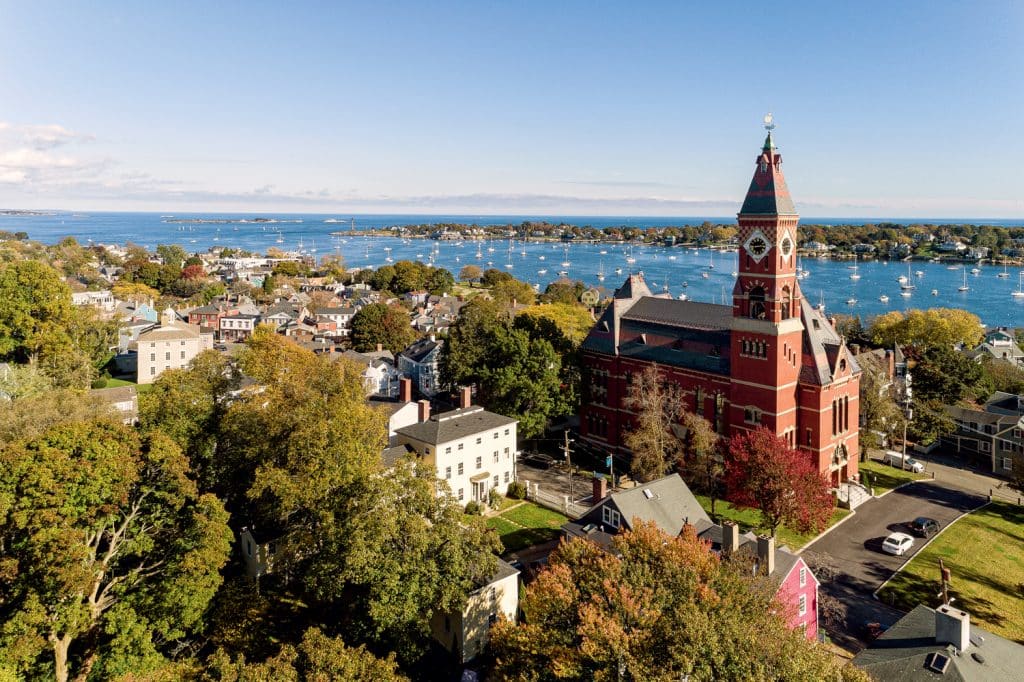
Photo Credit : Eyal Oren/Wednesdays in Marblehead
COASTAL TOWN: Marblehead, MA
Pop. 20,441 | Median Home $962,375
A breeze ruffles Marblehead’s harbor, having sailed in from across the world. Colorful houses grow mellow in the dusk as vintage-style streetlamps glow. A few blocks beyond the section known as Old Town, restaurant stovetops are fired up and diners settle in.
The houses look on, their historic markers reminding us that they’re here, too: Ambrose Gale, Fisherman, 1663; Mrs. Ruth Morse, Widow, 1750. Seafarers, shoremen, chandlers, and bakers. With so many vintage structures—300 or so—packed together so tightly, you can glimpse a cross-section of centuries at every turn. The town sits comfortably in its deep drifts of coastal history.
Sooner or later you’ll stumble across a yacht club here (there are at least six), but maybe that’s mandatory in a North Shore town set on a beautiful harbor just 17 miles from Boston. A quick scramble up the hill at Crocker Park, with its broad water views, confirms why Marblehead touts itself as America’s yachting capital, as well as the birthplace of the nation’s navy.
Duck inside F.L. Woods, a Marblehead institution since 1938, where sailors and aspirational landlubbers can pick up a mariner’s jacket or the latest Eldridge Tide and Pilot Book. Peruse new and classic titles at the excellent Saltwater Bookstore, and get a seafood fix with a tuna melt or poke wrap from Shubie’s Marketplace. And for a reminder of the mainland’s charms, please, oh please, duck into the flower shop Flores Mantilla, where Buddhas and birdbaths disappear into drifts of greenery. —Annie Graves
Worthy Alternative: Westerly, RI
Miles of powdery beaches. A historic downtown and its green centerpiece, Wilcox Park. Star chef Jeanie Roland’s Ella’s Food & Drink. Grey Sail Brewing. All this creates a small-town feel wrapped in coastal beauty that has attracted the likes of Taylor Swift. Toss in the tiny village of Watch Hill and its lovely Napatree Point Conservation Area, and you have reason enough to sing. Pop. 18,423; median home $515,000
Affordable Option: Eastport, ME
The easternmost town in the country attracts those who prefer the timeless purr of fishing boats to traffic, shopping centers, and cineplexes. The downtown holds handsome brick buildings and an art institute, and here an ethic of preservation and nature conservation runs deep. Pop. 1,288; median home $214,000

Photo Credit : Tara Schatz
CULTURE TOWN: Manchester, VT
Pop. 4,484 | Median Home $602,000
The best places often catch us by surprise with the mix of their ingredients. Settled in 1761, Manchester Village offers low-key elegance, “cottages” of every era, and white marble sidewalks. Then adjacent Manchester Center kicks in, with its designer outlets and lively independent shops such as Northshire Bookstore, whose 10,000-square-foot sprawl includes a vast collection of used and rare finds.
Just a few minutes from the streets of downtown is the serene Southern Vermont Arts Center, where sculptures dance through fields and forest, and art-filled walls enliven a historic mansion. There are workshops to sample, performances at the Arkell Pavilion, and sophisticated dining at the on-site restaurant. In summer, the hills are alive with the sounds of the Manchester Music Festival, now in its 50th year of classical music performances, talks, and master classes.
Manchester’s culture goes hand in hand with its outdoor beauty. The legendary Battenkill River has challenged fishermen for decades—not surprisingly, Orvis was founded here in 1856—and the American Museum of Fly Fishing illustrates the finer points of the sport, with lures appearing as tiny works of art. Abraham Lincoln’s son Robert was so dazzled by the landscape that he built his summer mansion, Hildene, here in 1905; it’s now a must-see house museum. And then there’s the natural masterpiece of Mount Equinox, at 3,848 feet, looming over all; ascend via the Skyline Drive to enjoy its breathtaking views, courtesy of the silent Carthusian monks who own it. —Annie Graves
Worthy Alternative: Ridgefield, CT
What do Roz Chast, Eugene O’Neill, and Maurice Sendak have in common? They’re all among the creatives who’ve lived in this picturesque culture hub less than 60 miles from Times Square. And the arts keep coming, with community and professional theater, an art museum, a history museum, and an orchestra, too. Pop. 7,228 (neighborhood of Ridgefield); median home $1.05M (neighborhood of Ridgefield)
Affordable Option: North Adams, MA
The arts scene in this former mill town gets a spectacular boost from Mass MoCA, the largest contemporary art museum in the country. There are also local galleries and artists’ lofts and the Massachusetts College of Liberal Arts; meanwhile, nearby Mount Greylock and Natural Bridge State Park are testaments to nature’s artistry. Pop. 12,961; median home $179,950
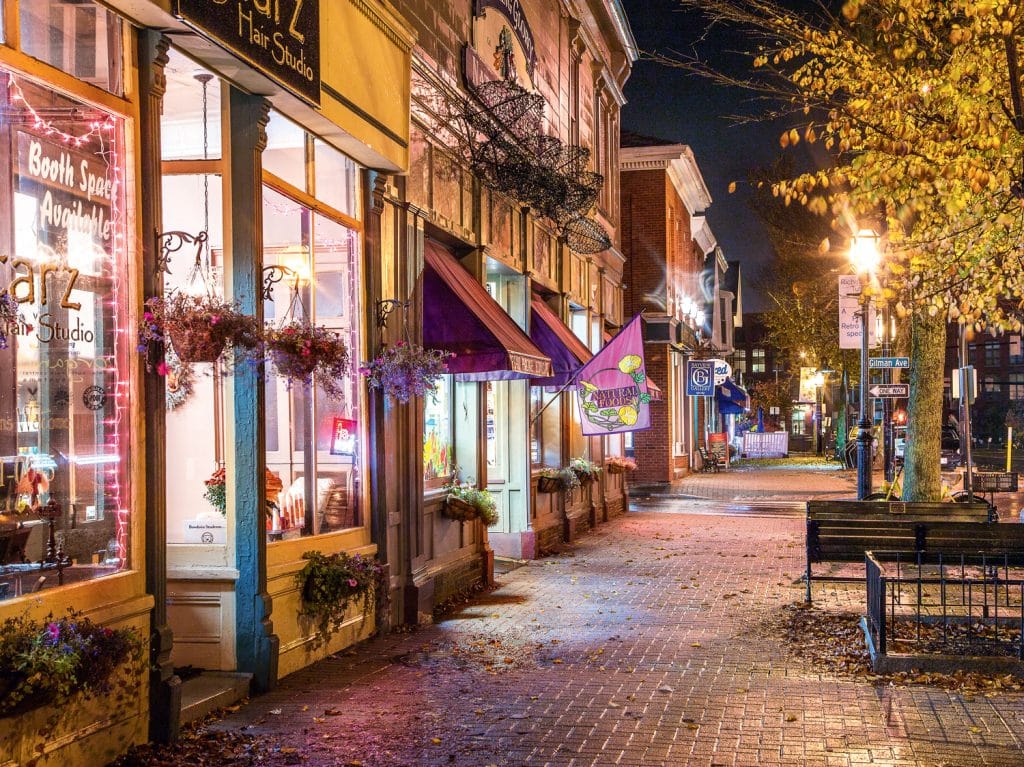
Photo Credit : Benjamin Williamson
COLLEGE TOWN: Brunswick, ME
Pop. 17,033 | Median Home $510,000
To see how town and gown fit together in Brunswick, begin at the historic mill complex Fort Andross and walk one mile south on Maine Street to Bowdoin College. Within a few blocks are two Indian restaurants, plus gelato and brick-oven pizza, homemade pasta, Japanese and Greek cuisine, and Maine seafood. One could dine out on Maine Street every day. Except—you’ll also want to cook at home with the local bounty of Brunswick’s summer and winter farmers’ markets.
Step inside Gulf of Maine Books and chat with poet-owner Gary Lawless, whose store has been a fixture since the 1970s and whose displays favor banned books. A bit farther along is Pleasant Street; turn here to find the wall mural Dance of Two Cultures. Christopher Card’s painting showcases the people and heritage of Brunswick and its sister city of Trinidad, Cuba; looking at it, you will feel this town’s embrace of inclusivity and multiculturalism.
Heading back to Maine Street, you’ll want to linger at the town green, which stays vibrant even in winter with its outdoor skating rink. The green flows to Bowdoin College and one of the most beautiful campuses in the country. Look around. Sit by trees planted before Hawthorne and Longfellow studied here. Explore the museums.
Then, after downtown Brunswick has won your heart, take a short drive to the Harpswell Peninsula. And as you soak in its ocean views, you may wonder: With all this, why would any student ever want to graduate? —Mel Allen
Worthy Alternative: Hanover, NH
Hollywood’s ideal college town would look just like this: streets lined with little shops and eateries that lead to a stately campus ringed by red brick buildings. Hanover also throws in a river for kayaking, a ski hill, an art museum, and access to the Appalachian Trail. Pop. 11,870; median home $1.13M
Affordable Option: Farmington, ME
When U.S. News & World Report put the University of Maine at Farmington in its top 10 for “best value” last year, it focused on UMF’s academics and in-state cost of only $10,989. Yet one should also factor in proximity to lakes and major ski resorts, upscale pubs and cafés, and a festival honoring native son and earmuff inventor Chester Greenwood. Pop. 7,592; median home $242,500
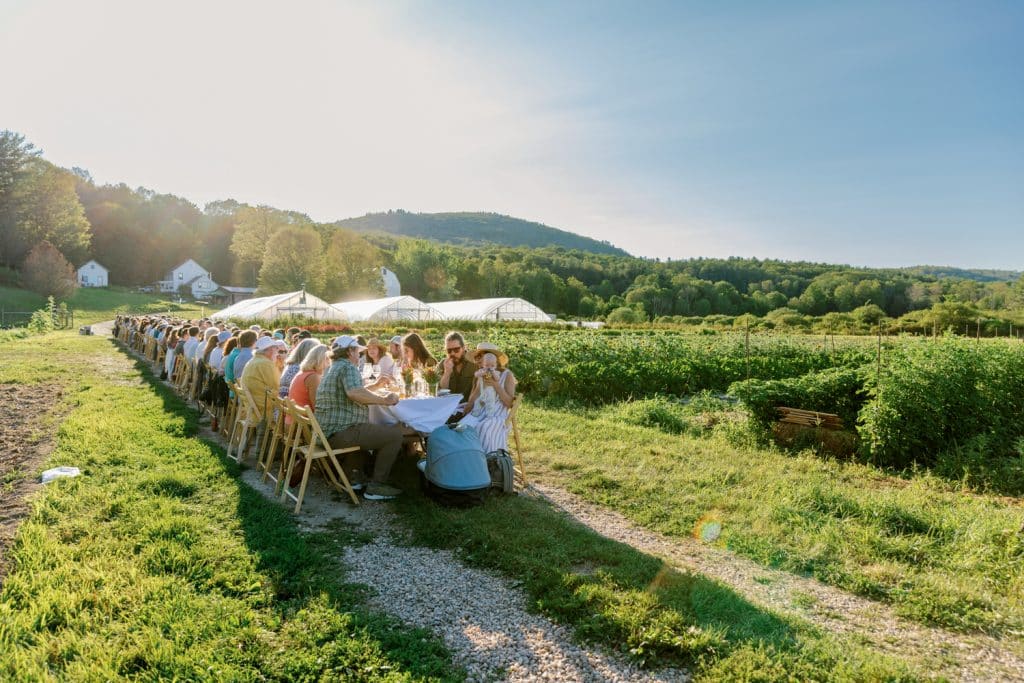
Photo Credit : Linda Campos
ECO-MINDED TOWN: Great Barrington
Pop. 7,172 | Median Home $505,000
Support of local farmers is fierce in Great Barrington, a culinary cradle in the Housatonic River Valley. Indeed, in this small town named one of America’s best by Smithsonian magazine, a closer look confirms a conscious commitment at every level of eating and drinking. Restaurants raise their own meats and produce. Barrington Brewery makes its beer with solar power. SoCo Creamery sources dairy for its ice cream from a family farm (and makes its own cookie dough, to boot).
But Great Barrington shows its eco-mindedness in other ways, too. The town’s embrace of “green” burials. A cohousing cluster of sustainably built cottages, recently featured on Dwell ’s website. An environmentally friendly approach to weddings at Saint James Place, a cultural center and event venue where “micro weddings” sidestep the 1 billion pounds of trash that U.S. nuptials generate annually.

Photo Credit : SoCo Creamery
There’s more. The Appalachian Trail Conservancy has designated the town an “Appalachian Trail Community” for its dedication to the legendary hiking route. At Refill GB, locals can restock on lemongrass laundry soap and work toward zero waste. Karen Allen Fiber Arts features natural-fiber sweaters that the actress weaves herself. And at Rubiner’s Cheesemongers & Grocers, the motto “Cheese is our thing” feels like an understatement as you survey the bounty of small-farm artistry displayed like edible platonic solids. Conscious and tasty living: It’s definitely something to chew on. —Annie Graves
Worthy Alternative: Belfast, ME
This coastal town hums with art, music, boating, and hiking. Home of the Maine Farmland Trust, it also has one of Maine’s largest food co-ops, a solar-powered firehouse, a town Climate Crisis Committee, and an Ecovillage cohousing community. Pop. 6,938; median home $370,000
Affordable Option: Rutland, VT
While skiers know it as a home base for Killington, Rutland is quietly gaining fame as a sustainable-energy capital. It has the most solar power per capita of any New England city, with its Stafford Hill Solar Farm alone producing enough electricity to run 2,000 homes. Pop. 15,807; median home $265,000

Photo Credit : Julie Bidwell
HISTORIC-ARCHITECTURE TOWN: Wickford, RI
Pop. 892 | Median Home $583,250
A village of North Kingstown set on western Narragansett Bay, Wickford can feel a bit like an island, with water views in every direction, even in the slivers between buildings. Streets uncoil like rope, with sea captains’ houses leaning back from the sidewalks. Dogs amble past with their people in tow. Mellow light smooths the rose-brick storefronts. Shade trees line up like parade spectators. It’s hard to believe you’re just 25 minutes from the bustle of Providence.
Recently named one of America’s 10 best historic small towns in a USA Today poll, Wickford has one of the densest collections of 18th-century houses in New England. It makes sense that “people whose hobby and love is restoring houses” are drawn here, says one longtime resident. Preservation is a fast track to fitting in, bolstered by groups like HistWick and Historic North Kingstown.
The local art scene, too, gets a big boost from the 400-member-strong Wickford Art Association, host of the annual summer Wickford Art Festival. But there’s a lot to be said for simply cruising the compact downtown, with its engaging assortment of storefronts clustered mostly on Main and Brown streets. From vintage furniture at Eclectic Bungalow to fine art at Five Main, and to clothing boutiques, pottery, Celtic jewelry, and yarn, it’s a fine excuse to slow down and soak up your surroundings. —Annie Graves
Worthy Alternative: Woodstock, VT
Woodstock has three—count them—National Register Historic Districts. At its heart is a lovely town green bordered by the 1892 Woodstock Inn and streets filled with buildings from late 18th to late 19th centuries. Plan a side trip to the Marsh-Billings-Rockefeller National Historical Park, whose 550 acres are anchored by a handsome 1805 mansion. Pop. 3,005; median home $1.05M
Affordable Option: Skowhegan, ME
Your great-grandparents would feel at home in Skowhegan’s historic district, with its nearly 40 buildings dating from 1880 to 1910. History also resonates in the oldest continuously held state fair in the country, the 1946 Skowhegan School of Painting & Sculpture, and the local movement for preserving heritage grains. Pop. 8,620; median home $249,000
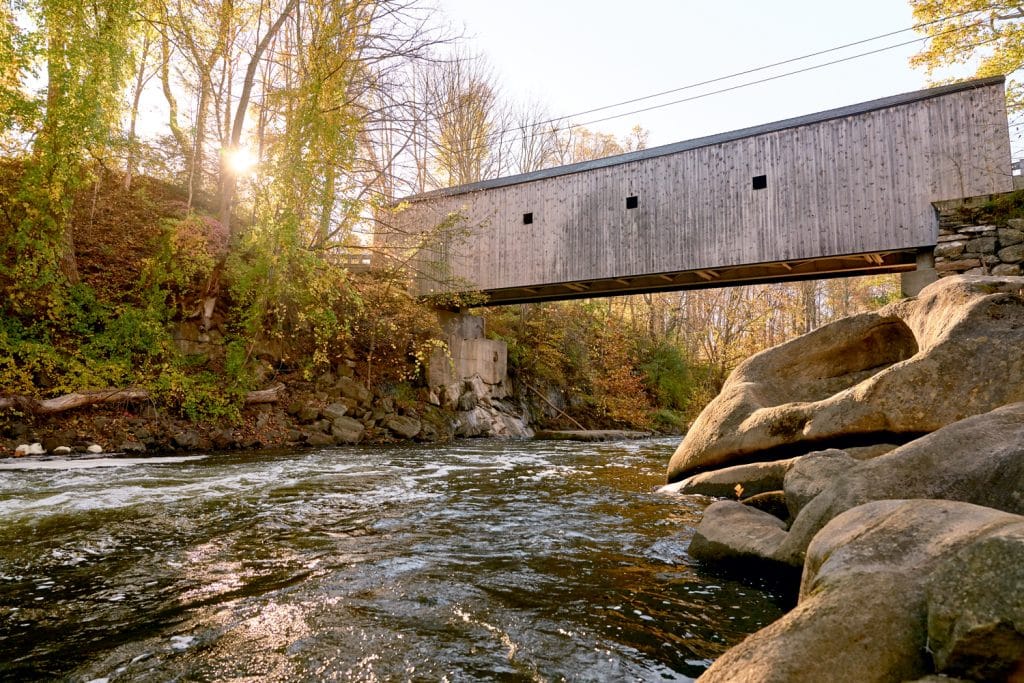
Photo Credit : Mark Fleming
REMOTE-WORK TOWN: Kent, CT
Pop. 3,019 | Median Home $509,500
You crave clean air and outdoor space to spare, but you’re still a bit tethered to a job, a business, or life in the big city. And, truth be told, you’re more than a little accustomed to dining at the restaurants of celebrated chefs. And wandering into world-class galleries whenever you want to spruce up your place. Is there really a country retreat where you can work remotely and gain far more than you sacrifice? Where you’re 20 minutes from a Metro-North train that can deposit you in the heart of Manhattan in less than two hours… yet even closer to a riverside stretch of the Appalachian Trail?
Yes, there is. It’s Kent, in far western Connecticut: the town Yankee famously named best for fall foliage. Sublimely scenic, surprisingly sophisticated, Kent claims three state parks within its borders, along with an independent bookstore, high-end decor showrooms like RT Facts, and restaurants headlined by Ore Hill—chef Tyler Anderson’s contemporary farm-to-table venture—just named to The New York Times’ annual best-in-America restaurant list.
You’ll have robust Internet here. And you’ll get used to the occasional dropped cellphone call. After all, working from home is all about flexibility. You’ll have that in spades as you rub shoulders with other balance seekers walking their tots to preschool, snagging bestsellers at a library book sale, or tapping keyboards and sipping frozen frappamochas at 45 on Main. Increasingly, the transplants aren’t just urban escapees. They’re down-to-earth families who simply want it all. —Kim Knox Beckius
Worthy Alternative: Barnstable, MA
While your kids are at sailing camp, you can be captaining your own enterprise. Barnstable’s seven welcoming villages are more connected than ever to the world beyond Cape Cod, thanks to posh coworking spaces, high-speed ferries, and added flights from the town-owned airport. Pop. 48,916; median home $690,000
Affordable Option: Berlin, NH
If you’re itching to put the emphasis on remote, Berlin may be the work-at-home hometown for you. The mountain views and square footage you’ll score in this former mill town on the Androscoggin would cost a bundle anywhere else. And the city’s first new mayor in 14 years is actively enticing entrepreneurs. Pop. 9,425; median home $180,000
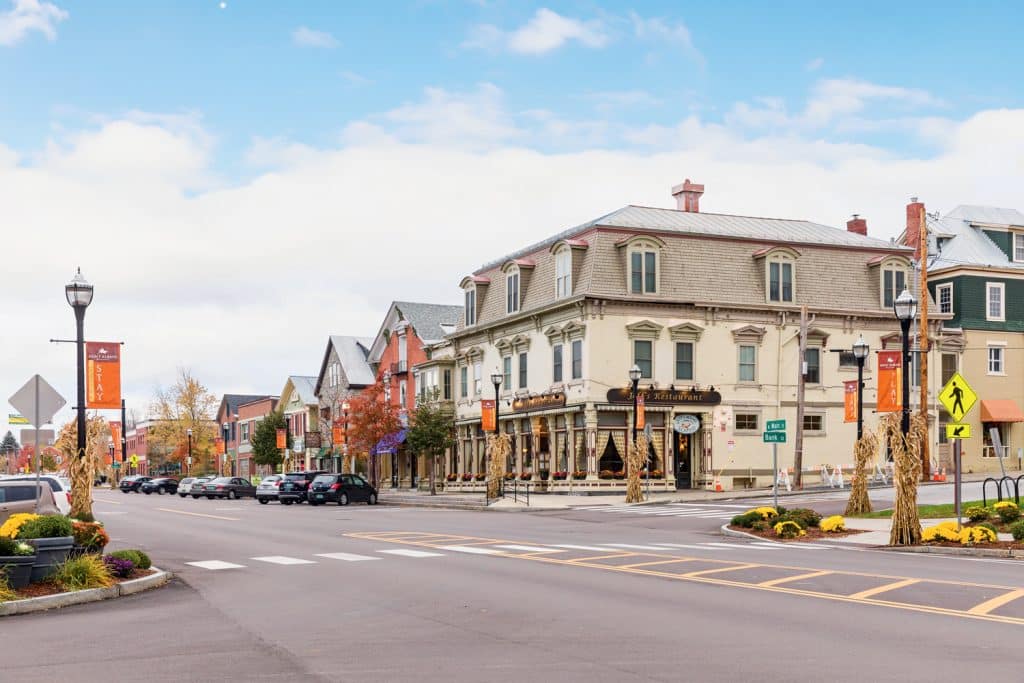
Photo Credit : Oliver Parini
REVITALIZED SMALL CITY: St. Albans, VT
Pop. 6,877 | Median Home $346,500
As small cities across New England plot their comebacks, St. Albans offers an inspiring look at what’s possible. Less than two decades ago, city leaders launched a plan to reverse a decades-long decline that had taken its toll on not just Main Street, but also the “spirit of the city itself,” says city manager Dominic Cloud. The revival began with a $3 million reimagination of downtown, which brought wider sidewalks, more trees, and the kinds of pedestrian-friendly areas that feel welcoming to visitors and locals alike.
Today, Main Street features a thriving food and drink scene, a terrific bookstore, and a robust summer farmers’ market in Taylor Park. Elsewhere, new buildings have gone up, historic ones have been restored, and multinational firms have set up shop. In a state that has struggled with declining population, St. Albans has seen its number of residents climb 16 percent since 2010.
Of course, this being Vermont, one is always close to the outdoors. Lake Champlain is on the doorstep, while the Hard’ack Recreation Area, a 95-acre public property, features an old-school ski hill, miles of hiking trails, and a year-round pool that stays a balmy 85 degrees even in the depths of winter. Community pride, meanwhile, is front and center during a wealth of annual events, from a winter carnival to special parent-kid dances (the Daughter Gala and the Son Shindig) at the all-new city hall.
“People come here and they see just how much is happening, and they ask, ‘Is it always like this?’ ” says Kelly Viens, a St. Albans native and the city’s longtime recreation director. “And my answer is always the same: ‘It really is.’ ” —Ian Aldrich
Worthy Alternative: Salem, MA
Since 2001, Salem Main Streets has been a driving force in this North Shore city that’s anchored in no small part by the Peabody Essex Museum, the nation’s oldest continuously operating museum. And Boston, 15 miles south, is just a short commuter-rail ride away. Pop. 44,482; median home $585,500
Affordable Option: Keene, NH
The splashy renovation of Keene’s historic Colonial Theatre continues to draw attention to its reenergized downtown. Keene State College’s pretty little campus flows into a central district with what’s been touted as the world’s widest paved Main Street, locally grown restaurants and shops, and one of the best art and music scenes in the state. Pop. 23,047; median home $330,000

Photo Credit : Carl Tremblay
RIVER TOWN: Chester, CT
Pop. 3,749 | Median Home $467,500
Just two hours from New York City or Boston, Chester settles into the nooks and crannies of hilly terrain along the banks of the Connecticut River, a mere 10 miles north of Long Island Sound. In a region shot through with sparkling waterways, Pattaconk Brook ducks under Chester’s Main Street, threading itself through a compact downtown that’s friendly, attractive, and cosmopolitan while still keeping close to its small-town New England character.
Character is key here: Though settled in 1692, Chester can be a bit Auntie Mame, with her “life is a banquet” attitude. It’s an artists’ enclave dotted with galleries and restaurants. It’s a walking town that “draws creative people,” according to one shopkeeper. It’s “a great town for kids and dogs,” says another. A full dance card of events, meanwhile, includes a Sunday farmers’ market, a Fourth of July road race, the Chester Fair (since 1877), and a townwide tag sale in May.
But Chester’s roots are curled around history, too. From April through November, the 1769 Chester-Hadlyme Ferryruns passengers across the Connecticut River to the century-old Gillette Castle, dribbled onto the cliffs like an eccentric, oversize sand castle. The Old Burying Ground creaks with tombstones from the 1700s, and the 1868 Chester Fife & Drum Corps is one of the oldest continuously active groups of its kind in the nation. And through all this, a beautiful river runs. —Annie Graves
Worthy Alternative: Portsmouth, NH
Portsmouth’s modest footprint belies all that it packs in: thriving arts and culture, au courant dining, colorful historic homes, and that town-within-a-town, Strawbery Banke Museum. The Piscataqua River runs alongside pretty Prescott Park, which hosts a full-bore summer extravaganza of outdoor entertainment. Pop. 21,956; median home $711,000
Affordable Option: Greenfield, MA
Sitting at the confluence of three rivers, Greenfield is a scrappy combo of rural and forward-thinking (its mayor calls it “rurban”). The first designated “green community” in Massachusetts lures visitors with diverse restaurants, vintage shops, local breweries, a pair of marquee music festivals (Green River and Wormtown), and the showstopping Franklin County Fair. Pop. 17,768; median home $320,000
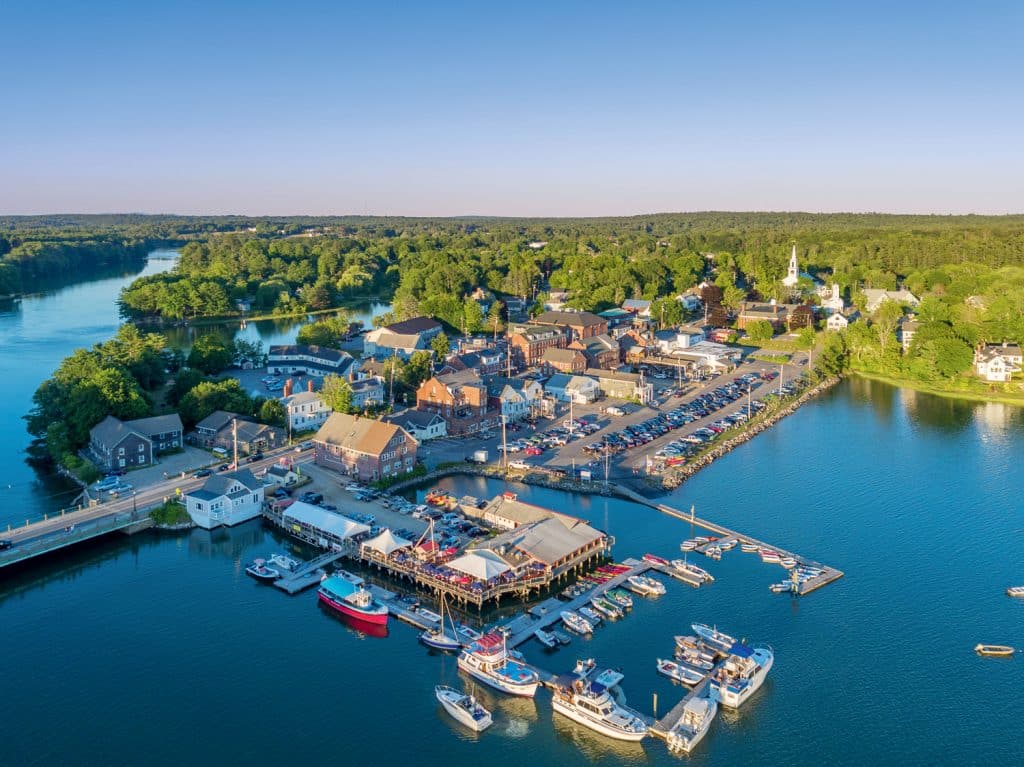
Photo Credit : Maine Aerial Photography Services
PICTURE-PERFECT TOWN: Damariscotta, ME
Pop. 2,297 | Median Home $459,250
Damariscotta would fall into the prettiest percentile of New England towns even if there were nothing to see beyond its dreamy little harbor on the tidal river that shares its name. It’s a classic coastal scene, complete with pleasure boats at anchor, a rollicking restaurant on the pier, and a white church spire closer to heaven than the treetops. But there are other visuals that make the town where Adam White set his 2022 bestseller, The Midcoast, a place where you’ll spend an inordinate amount of time snapping photos. From the ginormous banana splits at Waltz Soda Fountain, which hasn’t changed much in 75 years, to the luminous sunsets looking west toward the Great Salt Bay, preferably from the deck at Round Top with a cone of farm-fresh lavender ice cream in hand, there are sweet scenes galore to document.
Put down roots here, and your family may soon be growing… half-ton pumpkins. Of all the events that bring this community together, fall’s annual Pumpkinfest & Regatta is the zany zenith, and it all begins on Seedling Sunday in May, when townspeople adopt plants that will produce the giant pumpkins destined for use as art (or boats). Don’t imagine for a moment, though, that Damariscotta is lacking in more erudite culture. It has two resident theater companies and a cinema. It hosts Salt Bay Chamberfest concerts. Its library is supported handsomely by a volunteer-powered used bookstore that Yankee has named the state’s best. And the Peace Gallery brings neighbors together to stretch, create, and meditate. —Kim Knox Beckius
Worthy Alternative: Old Lyme, CT
The Connecticut River meets Long Island Sound near this town that’s so alluring, an Impressionist colony sprang up at the 20th century’s turn. Picture yourself taking art classes at the Florence Griswold Museum, paddling the Great Island salt marsh, and making coffee runs to an architecturally distinct Dunkin’. Pop. 7,628; median home $560,000
Affordable Option: St. Johnsbury, VT
If the Northeast Kingdom is Vermont unfiltered, St. Johnsbury is its red-brick Victorian outpost of civilization. It’s so cultivated, in fact, that its library houses about 100 framed masterpieces, and its most heartwarming attraction, Dog Mountain, is equal parts outdoor paradise for pups and enduring work of art. Pop. 7,364; median home $225,000
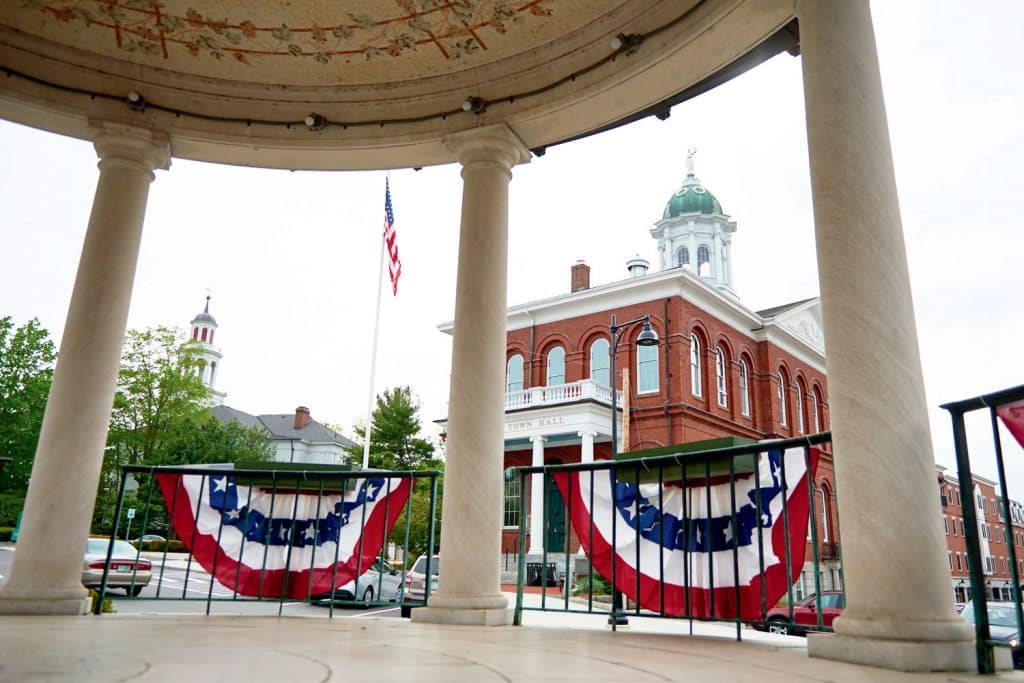
Photo Credit : Mark Fleming
WALK-TO-EVERYTHING TOWN: Exeter, NH
Pop. 16,049 | Median Home $627,500
Center yourself at Exeter’s classic town bandstand, and you’ll feel pulled in all directions—but that’s a good thing. The densely packed downtown will fuel you with perfectly brewed coffee at D Squared Java, distract you with Water Street Bookstore’s whip-smart picks, and feed your art-collector fantasies at galleries like Exeter Fine Crafts. You’ll also get a hefty hit of history: Founded in 1638, Exeter is filled with fine old buildings that hint at stories churning just under the surface, partly due to its proximity to the coast (eight miles) and its odd commingling of rivers (one sweet, one salty). The Squamscott and the Exeter entwine just behind the shops and cafés of Water Street, making Exeter a kind of thriving seaport without a sea.
Walk down Water Street to Swasey Parkway, and you might find a weekly farmers’ market or festival. You’ll also encounter a half-mile path that hugs a riverbank once lined with schooners and gundalows, but which today sees kayaks and the crew boats of Phillips Exeter Academy. That storied prep school has an outsize presence here, abutting downtown with a lovely 675-acre campus filled with walking trails galore and a generous helping of academic brick. And don’t miss the nearby American Independence Museum, which holds an annual post–Fourth of July party to mark the delivery of the Declaration of Independence to Exeter on July 16, 1776. —Annie Graves
Worthy Alternative: Provincetown, MA
It could easily take all day to absorb the diversions of Provincetown’s Commercial Street, with art galleries, waterside eateries, fragrant Portuguese baked goods, handicrafts and tchotchkes, meticulously kept historic homes, and that most glorious of pastimes: people-and-dog-watching. Pop. 3,664; median home $2.08M
Affordable Option: Brattleboro, VT
Cradled by steep hills along the Connecticut River, this artsy enclave packs its downtown with galleries, music venues, theaters, a food co-op, and cool restaurants. Also within an easy stroll: the Vermont Jazz Center, the Vermont Center for Photography, and the Brattleboro Museum & Art Center. Pop. 7,346; median home $329,000







